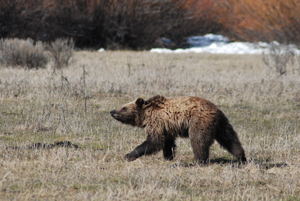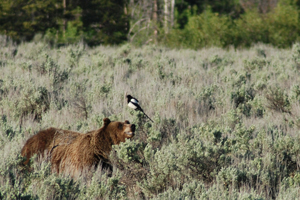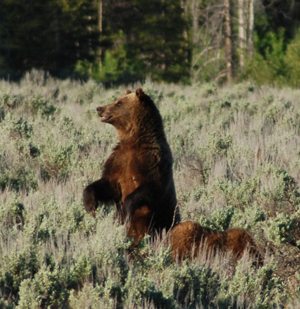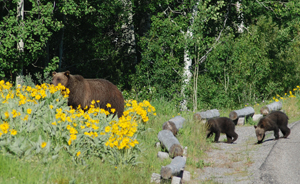The grizzly bear (Ursus arctos horribilis) is a subspecies of brown bear that once roamed the mountains and prairies of the American West. Today, the grizzly bear remains in a few isolated locations in the lower 48 states, including Yellowstone and Grand Teton National Parks.

Grizzly Bear (Photo credit: D. Lehle, NPS)
The name "grizzly" comes from silver-tipped or "grizzled" hairs on some animals' coats. However, the coloration of black and grizzly bears is so variable that it is not a reliable means of telling the two species apart. Particularly when bears are not fully grown or when seen only briefly or at a long distance, it can be difficult to correctly identify one bear species from another.
It is commonly said that grizzly bears cannot climb trees. This is not true, especially when the bears are small. As grizzlies grow larger and their claws grow longer, they have a harder time climbing. Stories that bears cannot swim or run downhill are also untrue. Grizzlies can swim, run up and downhill, and sprint up to 40 miles per hour.
Bears are generally solitary, although they may tolerate other bears when food is plentiful. Mating season occurs from mid-May to mid-July, and bears may mate with multiple partners during a single season. Females do not breed until at least age 4 or 5. Bears experience "delayed implantation," meaning that the embryos do not begin to develop until late November or December. This appears to be a strategy allowing the mother bear to save up energy until entering her winter den, where the cubs are born in late January or February. A litter of one to three cubs is common, litters of four cubs occur occasionally. Male bears take no part in raising cubs and may pose a threat to younger bears. A mother grizzly will usually keep her cubs with her for two winters following their birth, after which time she (or a prospective suitor) chases the subadult bears away so she can mate again. Female cubs frequently establish their home range in the vicinity of their mother, but male cubs must disperse farther in search of a home.
Grizzly with cubs-of-the-year (Photo credit: D. Lehle, NPS)
They can be effective predators, especially on such vulnerable prey as elk calves and spawning cutthroat trout. They also scavenge meat when available, such as from winter-killed carcasses of elk and bison, from road-killed wildlife, and from wolves and cougars. They eat small mammals (such as pocket gophers) and insects (such as ants and army cutworm moths that summer on high-elevation talus slopes), both of which provide important, high-protein food. A grizzly's long claws and strong shoulders enable it to efficiently dig for roots, bulbs, corms, and tubers, and rodents and their caches. They also eat a wide variety of plants, including whitebark pine nuts, berries, sedges, grasses, glacier lilies, dandelions, yampas and biscuitroots, horsetails and thistles. They will eat human food and garbage where they can get it. This is why managers emphasize that keeping human foods secure from bears increases the likelihood that humans and bears can peacefully co-exist in greater Yellowstone.

Grizzly and Black-billed Magpie share an elk carcass
(Photo credit: D. Lehle, NPS)
Grizzlies have a social hierarchy that determines which bears dominate the best habitats and food sources:
--adult males
--lone adult females, females with two-year-old cubs; females with yearlings
--females with cubs of the year
--subadults of either sex
Subadult bears, who are just learning to live on their own away from mother's protection, are most likely to be living in poor-quality habitat or in areas nearer roads and developments. Thus, young adult bears are most vulnerable to danger from humans and other bears, and to being conditioned to human foods. Food-conditioned bears are removed from the wild population.
Like black bears, grizzlies spend most of their time feeding. This effort increases during "hyperphagia," the predenning period in autumn. They locate or excavate dens on densely vegetated, north-facing slopes between 6,562-10,000 feet. Grizzlies enter their winter dens between mid-October and early December. Although grizzlies are considered true hibernators (see black bear description for more on this), they do sometimes awaken and leave their dens during the winter.

Grizzly and cub (Photo credit: D. Lehle, NPS)
Living with wildlife challenges all of us. Whether you are visiting the John D. Rockefeller, Jr. Memorial Parkway on vacation or living in the valley of Jackson Hole, encountering wildlife in their own environment is a thrilling and potentially dangerous situation.
Observing and photographing wildlife draws many to this beautiful place; seeking out the smallest calliope hummingbird or the largest grizzly bear. We all share a responsibility to protect ourselves and the park's animals. Always maintain a distance of at least 100 yards from bears and wolves, and 25 yards from all other animals. Never position yourself between an adult and its offspring. Females with young are especially defensive. Let wildlife thrive undisturbed. If your actions cause an animal to flee, you are too close.
Whatever brings you to this special place, remember the spectacular mountains and the diverse wildlife you see. We hope you will be refreshed and restored during your visit and remain connected to this place long after you return home.
-DL
Source:
Yellowstone National Park. 2012. Yellowstone Resources and Issues Handbook: 2012. Yellowstone National Park, WY.

